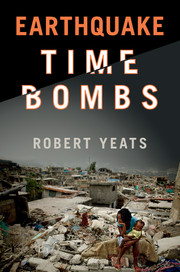Book contents
- Frontmatter
- Contents
- Acknowledgments
- Why this book?
- PART I EARTHQUAKES, DEEP TIME, AND THE POPULATION EXPLOSION
- PART II EARTHQUAKE TIME BOMBS
- TIME BOMBS WHERE THE PROBLEM IS UNDERSTOOD, BUT THE RESPONSE IS STILL INADEQUATE
- 6 San Francisco Bay Area
- 7 Los Angeles
- 8 Seattle, Portland, and Vancouver: Cascadia subduction zone
- 9 Japan: Tokyo and the Kansai
- 10 Wellington, New Zealand
- 11 Santiago, Chile
- 12 Prologue in central China
- OTHER TIME BOMBS, INCLUDING CITIES THAT ARE NOT WELL PREPARED
- PART III SUMMARY AND RECOMMENDATIONS
- References
- Index
6 - San Francisco Bay Area
from TIME BOMBS WHERE THE PROBLEM IS UNDERSTOOD, BUT THE RESPONSE IS STILL INADEQUATE
Published online by Cambridge University Press: 05 November 2015
- Frontmatter
- Contents
- Acknowledgments
- Why this book?
- PART I EARTHQUAKES, DEEP TIME, AND THE POPULATION EXPLOSION
- PART II EARTHQUAKE TIME BOMBS
- TIME BOMBS WHERE THE PROBLEM IS UNDERSTOOD, BUT THE RESPONSE IS STILL INADEQUATE
- 6 San Francisco Bay Area
- 7 Los Angeles
- 8 Seattle, Portland, and Vancouver: Cascadia subduction zone
- 9 Japan: Tokyo and the Kansai
- 10 Wellington, New Zealand
- 11 Santiago, Chile
- 12 Prologue in central China
- OTHER TIME BOMBS, INCLUDING CITIES THAT ARE NOT WELL PREPARED
- PART III SUMMARY AND RECOMMENDATIONS
- References
- Index
Summary
The discussion begins with San Francisco because that region had to confront its earthquake hazard much earlier than did Los Angeles. San Francisco became a boom town starting in 1848, when gold was discovered at Sutter's Mill in the foothills of the Sierra Nevada, followed by the arrival of the trans-continental railroad in 1869. In 1857, before the arrival of the railroad, the central California Coast Ranges were struck by the Fort Tejon earthquake of magnitude 7.8, but this earthquake struck thinly populated regions in the back country and had relatively little impact on California history. However, a few years later, on October 8, 1865, the “Great San Francisco Earthquake” struck the San Francisco peninsula, with its epicenter south of the city, near San Jose. Mark Twain, a journalist who had just been fired from his job at the San Francisco Morning Call, wrote about his experience in that earthquake to revive his sagging fortunes. Three years later, on October 21, 1868, another “Great San Francisco Earthquake” struck near Haywards (now Hayward) east of the Bay. At least 30 people out of a total population of 150,000 lost their lives. Unlike the Fort Tejon earthquake, the 1865 and 1868 earthquakes struck heavily populated areas and got the attention of the general public, as well as the concern of people on the East Coast who had been interested in investing in development of the new state of California.
The Chamber of Commerce appointed a committee of wealthy merchants to assure potential East Coast investors that well-constructed buildings were safe. A committee of scientists appointed by the Chamber of Commerce documented damage of about $1.5 million, but under pressure from the business community the report written by scientist George Davidson, chairman of the committee, was never published for fear of scaring off investors. Author Bret Harte wrote in 1866, after the first “Great San Francisco Earthquake,” that “there is more danger of the concealment of facts, or the tacit silence of the public press on this topic, than in free and open discussion of the subject.” An excellent point, but an open public discussion of the two earthquakes was not to be.
Forty years later, on April 18, 1906, the Bay Area was rocked by an earthquake of magnitude 7.7, accompanied by surface rupture on the plate-boundary San Andreas fault.
- Type
- Chapter
- Information
- Earthquake Time Bombs , pp. 80 - 84Publisher: Cambridge University PressPrint publication year: 2015



